| Article ID | Journal | Published Year | Pages | File Type |
|---|---|---|---|---|
| 2098440 | Trends in Food Science & Technology | 2016 | 15 Pages |
•Due to their characteristics, QDs are preferable over organic dyes for imaging.•Adhesion methods of QDs used biology can be used in other areas such as Food Science.•Multicolor imaging of water and food borne pathogens can be achieved with QDs.•Tracking food proteins in their real matrix give a better understanding of their role.
Quantum dots are inorganic semiconductor fluorescent nanoparticles with a size in the range of 1–10 nm. There are many semiconductor combinations that are used but the most popular and widely used consist of a CdSe core and can be functionalized in different ways when coated with polymers. Their application in Biological sciences has been widespread but few articles report the use of quantum dots in Food Science. The results obtained so far in limited applications show a promising future. In Food Science, they have been used mostly to detect pathogenic bacteria, and proteins. The applications in biological sciences are reviewed since they constitute a path of applications that can be emulated in other fields and the initial uses in Food Science are reviewed to encourage others in the field to take a closer look and benefit from the opportunities offered. Limitations and opportunities in the methods used in Food Science are discussed in order to simplify the work for researchers interested in using quantum dots as markers. The two methods used to attach quantum dots to bacteria and proteins in Food Science were broadly used previously in biological systems. The aim of this review is to show how quantum dots have been used in Food Science, and enhance their use.
